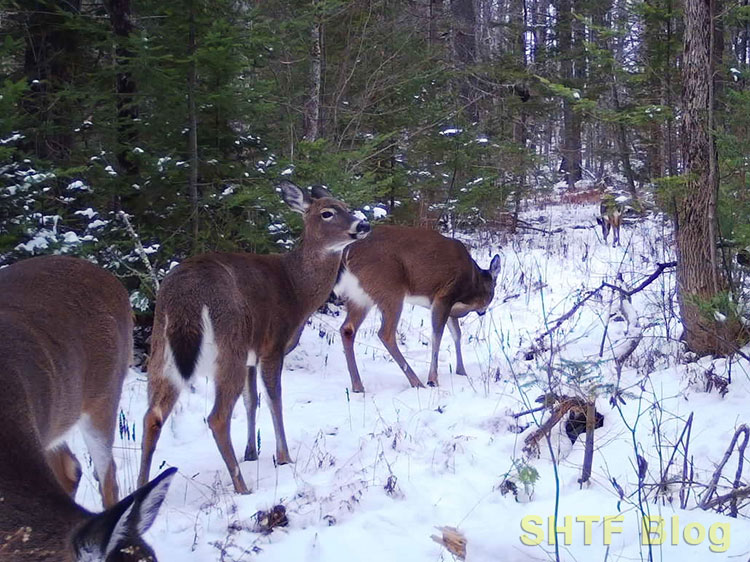
Deer season approaches and as hunters begin to scout territory. Novice hunters might wonder what deer like to eat. The answer to this question could impact where they place their stand, food plots they might have in mind, etc. This question on what they like most to eat could also be important to photographers and people who just like to watch deer in their yard. Having a basic understanding of deer biology can do wonders for hunters.
As of this writing, in my neck of the woods, we’re in desperate need of rain. Our normally green fields have turned brown and, of consternation to some, deer sightings are increasingly scarce. Personally, I’m a whole lot more worried about the overall effects of our dry spell than the short-term health of the herd. It’s not like deer just pack their bags and move to more accommodating climes.
Deer’s three essential requirements are cover, food, and water. If they are not pressured by human activity, many whitetails will live out their entire lives in a relatively small area, often less than 1 ½ square miles. Thus, it’s safe to assume at the moment, fresh deer sign will be found near local wet spots, swamps, streams, and ponds. However, one deer related concern is the status of my recently planted food.
Food Plots vs Mother Nature
During the past several decades, the management of deer populations has evolved to a true science. Best viewed as a holistic approach, it involves habitat through nutrition. And plantings – referred to as “food plots” – are often part of the process.
Supplemental Planted Foods
A food plot is essentially a garden of whitetail favorites, typically planted with clovers, brassicas, chicory, radishes, or other greens. Size can vary from acres to backyard-sized plots. For some, food plots may seem unsporting – like shooting fish in a barrel. That may hold true in some regions of the United States, but it certainly doesn’t apply everywhere.
I’ve maintained the same small quarter-acre plot since 2014. The number of deer taken in it while actually feeding is exactly one – a doe that filled the freezer during a year with limited hunting time (more to follow). So much for fish in a barrel. Then again, our state’s overall hunter success rate during the month-long firearms season is a dismal 16%.
This situation changed for the better during the past few seasons, but a combination of harsh winters, large aggressive coyotes and spotty food sources can cause rapid reversals. Like other colder regions of the country, Maine’s deer reside near their northern limits. Thus, the overall health of the herd depends on how they enter the lean months.
Competing Natural Foods
My area’s recent deer spike may be attributable to a succession of massive acorn crops. The last boom occurred two years back, after another hot and dry summer (seems to be a connection there). A welcome dousing of September rain added life to our clover and brassica plantings, but a strong October gale generated spectacular showers of acorns.
From that point on, the woods were strewn with a bonanza of highly prized calories, freeing the greens-starved deer to feed at their leisure. Food plots in these parts became little more than pit stops until the arrival of our first deep snow – timed perfectly for the closing of our deer season.
Did that mean our efforts were wasted? Nope, quite the opposite.
The deer knew they were there all along. The expedient alternative to random digging for acorns was a simple beeline to our nutrition-rich greens. By then it was mid-December, the annual rut (breeding period) was over, and many mature does were pregnant. Winter conditions were typical – severe by southern standards – but deer mortality remained relatively low thanks to a good nutritional start.
Weather Wild Cards
The following year’s summer was the opposite: Greens of all types assumed near jungle status due to a record-setting wet July and August. We dutifully replanted our food plots, which produced plenty of good forage. However, fall remained warm and wet enough to sustain a variety of wild greens – once again relegating our food plots to ala carte status.
Acorns were non-existent, and wild apples (another deer favorite) were spotty, but the deer scored another winter reprieve via the weather. Despite frequent sub-zero nights, prolonged periods of deep calorie-burning snow were absent. Of great relief, when the first hints of April’s green-up occurred, deer suddenly appeared in large numbers each evening throughout many of our local fields.
Feeding Patterns
As a general rule, most daytime deer activity occurs during early mornings and late evenings. The AM period may run a couple hours beyond first light, but the prime PM time is often the final hour. But this routine isn’t set in stone: Human activity, moonlight, weather, and food can influence these patterns – along with the rut.
Anything goes during that short breeding period (see below). Also, severe winter conditions can increase daytime der activity. In fact, how deer are able to survive harsh winters is story in itself.
What Deer Like to Eat in Each Season
Let’s take a quick trip around the calendar to see what deer like to eat as the calendar moves along, beginning a week ahead of winter’s official December 21st start. Its onset, and the conclusion of the annual rut, result in dramatic changes to the behavioral patterns of whitetails.
Winter: The Season of Lean Cuisine
By mid-December, in most northern climes, the rut (period of intense breeding) is over, and, for all deer, the number one priority becomes food. As the cupboard grows increasingly bare, it’s a time when deer are drawn to any remaining greens and residual crops.
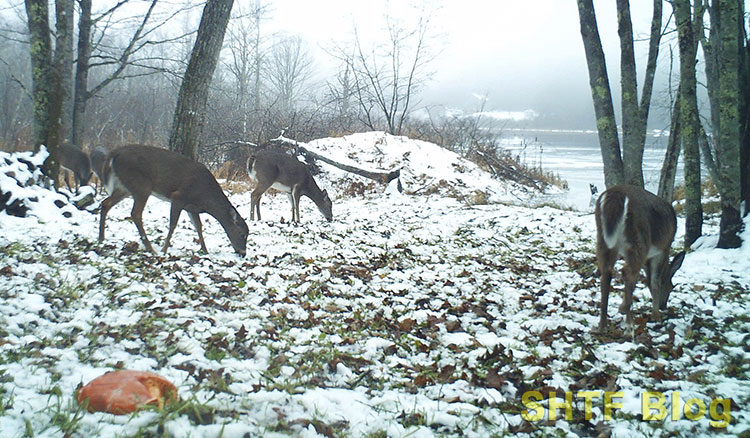
In the winter, deer will eat cedar, any acorns they can find, grasses, and certain plants they can find. When desperate they will even eat twigs and stems.
When these sources disappear, they head for the woods to live off maple shoots and other woody browse. Antlers become nothing more than extra baggage for bucks, so they’re usually shed by February. Different from the southern states, during winters when snow restricts daily movements, our deer “yard up,” sometimes traveling miles to small areas offering thermal cover (cedar being a favorite) and food.
This phenomenon typically occurs when snow depth is measured in feet. The actual “deer yard” may consist of only several calorie-saving acres, deeply rutted with trails traversed by large numbers of deer. This won’t escape the attention of our large northern coyotes, the ultimate opportunists. Any deer is considered fair game, although half-grown fawns suffer the greatest losses. Starvation is the other big killer, forcing deer to take what they can get.
In my area, hungry deer are actually attracted to the sounds of busy chain saws associated with commercial wood cutting operations. They’ll often be seen browsing the tops of felled maples upon the morning arrival of the crew – or, sometimes while a saw is running at the opposite end of a tree!
Winters that see less snow provide opportunities for deer to roam, although they’ll often curtail daily movements to conserve calories. Last winter, as noted above, prolonged periods of deep snow were absent in my area and, when the sun set, the deer boldly shopped for any available edibles.
Based on previous experience, I knew a row of ornamental cedar trees only feet from the house would be reduced to shreds by overnight marauders. Some folks wrap ‘em with burlap or use repellants. Preemptively, I relocated one four-legged miscreant to my freezer and managed to hold off the others by spreading the daily deposits of my Labrador retriever around their roots.
The winter prior though, ornamental shrub damage was minimal, thanks to the huge crop of acorns that provided ongoing nourishment.
But March can be a dangerous time when deep snow lingers. A period of rain, followed by a refreeze, can create a crust thick enough to hamper feeding efforts. Worse, it can also bog down deer – while supporting the weight of hungry coyotes. These winter challenges are endemic to many regions of the country. Bottom line: Deer that make it to spring have been through the wringer – and they’ll be craving a diet of fresh greens.
Spring: The Season of Renewal, and the Opening of the Salad Bar
In spring, deer have plenty to eat as the long-awaited retreat of snow initiates the early spring “green-up” phase begins offering buds and fresh greens to eat. As southern-facing slopes turn green, hungry deer will follow, sometimes congregating in large numbers. At that point, they’re over the hump. Food, water, and cover become abundant.
Pregnant does can regain the vital nutrients needed to deliver healthy fawns during late May/early June – some of which could come from emerging peas and beans. However, deer seldom have it made in the shade. During the same time, relentless swarms of biting black flies appear to inflict non-stop daytime misery.
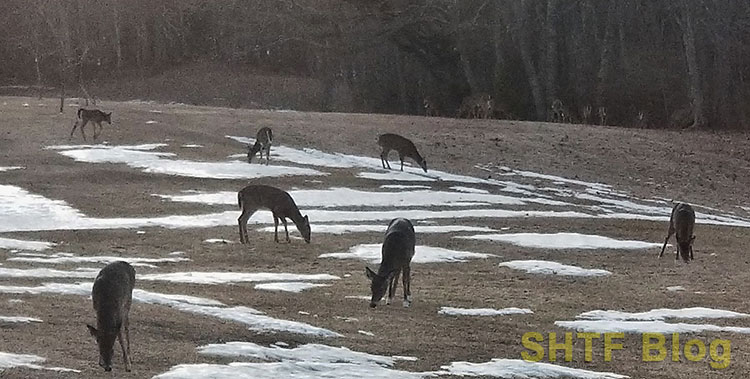
Summer: The Season of the Greens Buffet, Fawn Rearing, and Antler Growth
Summer, like spring, offers a lot of food for deer. They will eat everything from berries, weeds, vines, mushrooms, grasses to landscaping around suburban homes (they love hosta).
Early mornings and late evenings are ideal times to observe does with their fawns, usually born as singles or twins, but occasionally as triplets. And while they’re learning how to be deer, many plant-based sources of natural and agricultural origins may make the menu – to include lettuce and the tops of beets, radishes, and potatoes.
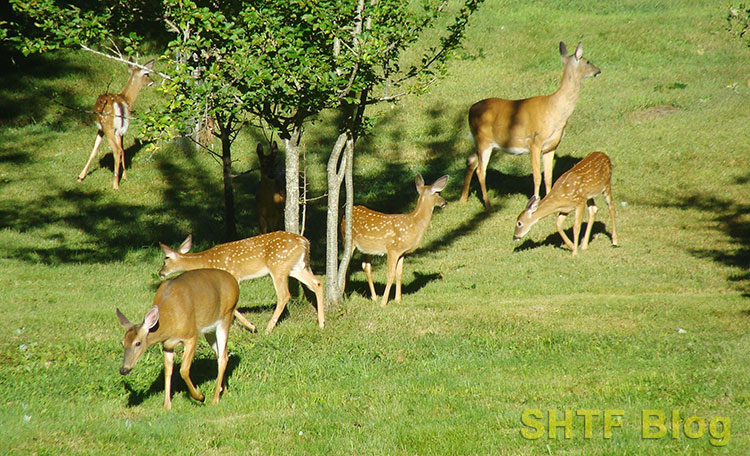
Meanwhile, bucks will be growing new antlers with velvet-textured exteriors, and, during late August, small groups may appear in fields as the sun dips below the horizon. Late summer also marks the ripening of berries and tasty garden attractions, as well as the beginning of available mast crops.
With bugs on the way out, little hunting pressure, and an increasing menu of delicacies, late summer and early fall are happy times for deer.
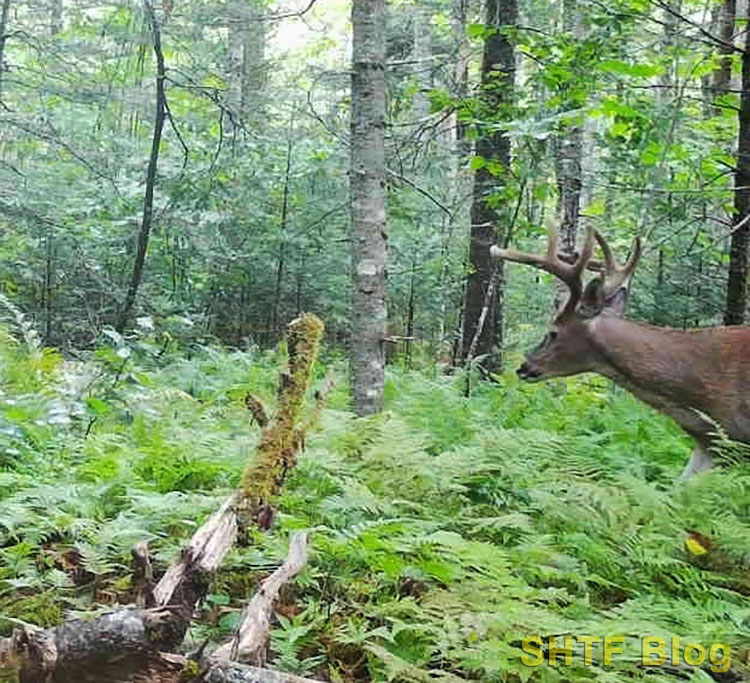
Fall: The Season of Abundance, Romance – and Danger
In the fall, deer will continue eating much of the same foods as summer, but as nature’s green gives way to brown and gray, they will fatten up for the rut on any nuts they can find and other new foods that become available, including apples, corn, and pumpkins. General browse will also remain a staple.
Given the huge geographic area that whitetail deer call home, our northern New England conditions no doubt differ greatly from more southern regions. By the end of August, maples show telltale hints of fall, and, by mid-September, many are ablaze in a riot of orange and red foliage.
For both hunters and deer, it’s also harvest time. For deer, it’s the perfect opportunity to pack in essential calories needed to endure the non-forgiving cold months only several weeks way. Because it’s also a season of change, food sources rapidly come and go.
During October, frost takes its toll on greens, and, in my area, the woods are stark gray by early November. The same seasonal shift also kicks off the breeding cycle, evidenced by scrapes (or “pawings”) and rubbed trees, the calling cards of bucks. October, in many states, means archery season, even crossbow hunting for deer.
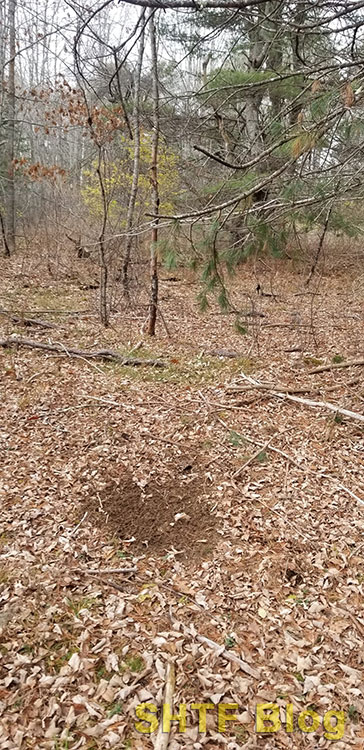
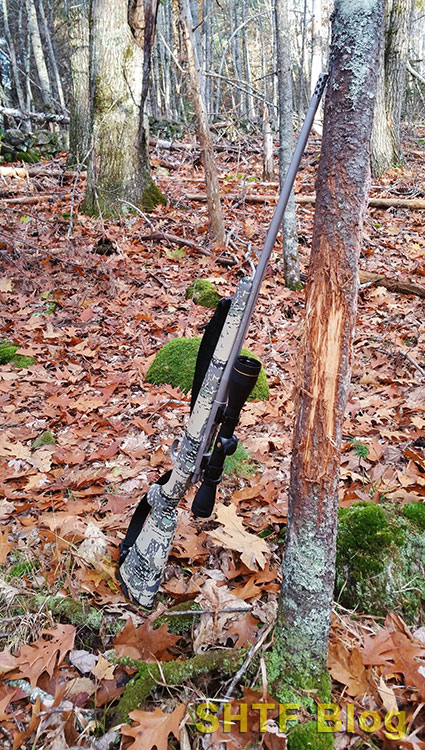
It’s also when they assert their dominance by putting their shiny new headgear to use – sometimes with injurious consequences. The actual “rut” is the period of peak estrus; a several-day stretch when most does come into heat. In many northern states including mine, the rut fires up around November 15th (later in southern regions), causing love-struck bucks to frenetically roam in search of receptive does.
For hunters, it’s a great time to stay in the woods throughout the entire day. For insurance adjusters and collision repair centers, it’s a busy spell. As part of nature’s cycle, those does that have been bred drive off their fawns, which are old enough to fend for themselves. Any fertile does that haven’t been bred – including some larger fawns – spark a second rut one month later.
And Twelve Months Later…
We’re back to where we started. It’s mid-December and the party’s over. The more aggressive bucks are battered, worn out, and thin. For them, as well as other deer that survived hunters and highways, all efforts must shift to life-sustaining calories. And with luck, they’ll score some leftovers from the menu of hardier fall foods.
Deer Hunting in Fall with Food as a Focus
Being the most heavily forested state in the nation (roughly 90%), Maine’s agricultural food sources are more limited than those of the prime central and mid-west regions. We have our share of farms, but many probably qualify as gardens by comparison. Still, squash, broccoli, cabbage, turnips and pumpkins can take a drubbing, often just prior to their scheduled harvests.
This can cause the home gardener who has put a lot of time and effort into growing a food bounty to carry them through the winter to become… a bit annoyed, perhaps angry. There are steps that can be taken to coexist with deer, but it takes some advance planning.
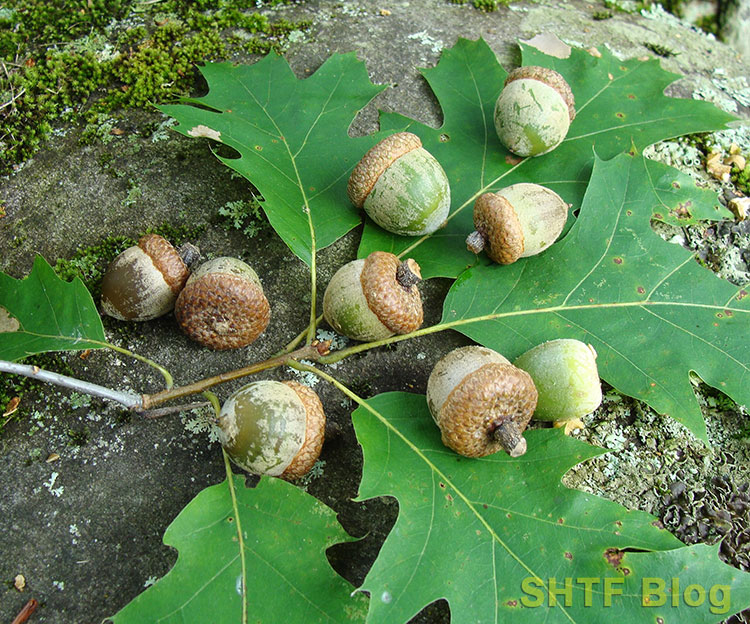
Standing corn takes some abuse, but it’s less of an attractant in my area. But throughout much of their range, deer zero in on natural mast crops like hickory, beech, and acorns. In my immediate area, the main target is carbohydrate-rich acorns.
Acorns
In total, somewhere around 90 species of oak dot the U.S., but for hunters, most fall into red oak or white oak categories. The latter are highly prized but both species are sure deer attractants – in years when they’re available. For hunters though, boom crops within larger stands of oak can make deer patterning difficult. Because these spots are usually more open at ground level, they also provide less daytime security, a situation remedied by hunting near bedding cover.
Apples
Throughout much of my area, wild apple trees are common. Many are the vestiges of overgrown farms, and those that produce are typically magnets for deer. In a “normal” fall, these concentrated sources of deer activity may not see the greatest traffic until Veteran’s Day.
But during a bone-dry season (like this one), deer may be into them by late summer – assuming there are apples that year. Some are seasons are phenomenal, others are spotty. Find a thorn-apple studded tree during December and you’ll have a deer hub!
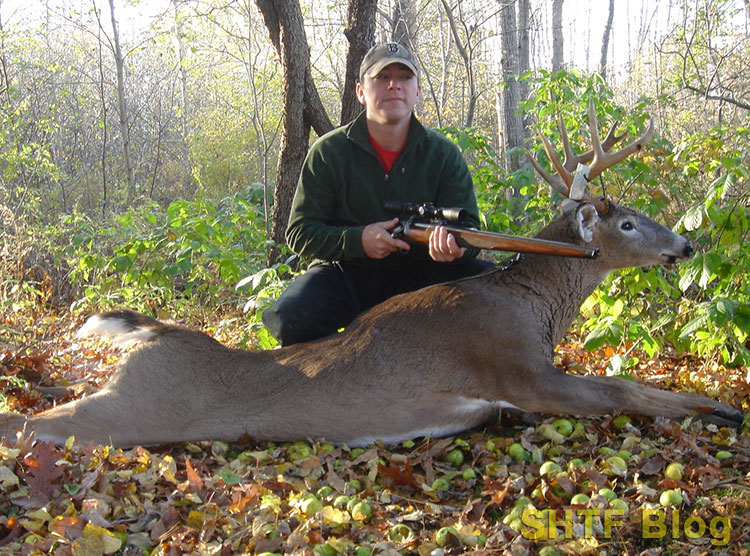
Other Entrees
Nature’s early season deer favorites include raspberries, choke cherries, mushrooms, and assorted greens but, even with the intel provided by motion-activated “trail cameras”, a smorgasbord of rapidly changing feeding options can throw a monkey wrench into hunting strategies.
As these foods disappear, remaining entrees (like mast crops) constitute an increasing share of the diet. For those of us with deer tags, this situation tends to improve throughout fall – but weather can add surprises.
Shop Trail & Game Cameras at Cabela’s
Late-August update: We’re currently receiving a bout of welcome rain driven by stiff winds and, suddenly, plump half-grown acorns are appearing beneath oak trees. Thus, subject to change, assuming the dry spell continues, connecting water to oak could be the key to freezer full of venison.
My son will no doubt hang a tree stand on the edge of a large, secluded swale swamp beneath an oak knoll offering the three essentials: food, water, and cover. No doubt, both he and I will also spend some evenings at well-trafficked apple trees. I’ll be hunting oak as well but, by design, the grove will be in a natural chokepoint bordered by water, thick cover – and the edge of my food plot.
Food Plots
The “we” in my circle consists of three serious deer hunters, all of whom own enough property to maintain food plots. Mine is comparatively small and, although I’ve only taken one deer that was actually feeding in it, the immediate area has been a steady producer. Some deer were just passing through.
Others appeared in the adjacent oak grove. The actual plot does serve as a draw, but it’s really just part of the larger picture – and I still don’t put all of my eggs in that basket. Another member of my crew goes all-in via two large-scale plots hunted almost exclusively. My son maintains two small plots, but his overall strategy is highly diversified.
Done right, food plots can work, but they aren’t necessarily an end-all. They require plenty of planning and labor. Soil tests, tilling (tractor), along with applications of lime and fertilizer must precede planting, followed by weed control measures. And, of course, suitable seeds must be planted at the right times. Because Whitetail Institute has the process down to a science, we rely heavily on their expertise and products.
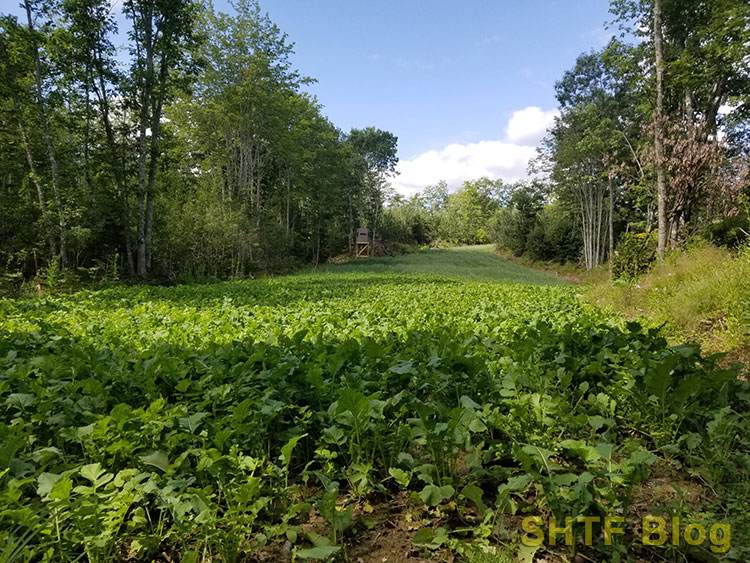
- Packed with ANTLER-BUILDING protein
- Helps does deliver HEAVIER, HEALTHIER fawns and produce more milk
- EXTREMELY cold tolerant as well as heat and drought resistant
- Coated with RainBond for ENHANCED seedling SURVIVABILITY
- Lasts up to 5 YEARS from a SINGLE planting
Baits & Feeders
Baiting is legal in some states (and provinces) like Texas, whereas in mine, unlike plantings, it’s considered a cardinal sin. However, our deer can be legally fed during months closed to hunting. Nowadays, the methods are similar, using battery-powered game feeders (large drums), set to dispense feed at programmed times.
- Large 325-pound capacity
- Automatic feeder with up to 4 feed times per day from 0-20 second each
- Outfitted with All-In-One Quick-Lock Feeder Kit
- Runs on 4 AA batteries (not included)
- Power Outlet for solar-panel installation
What About Feeding Deer in Winter?
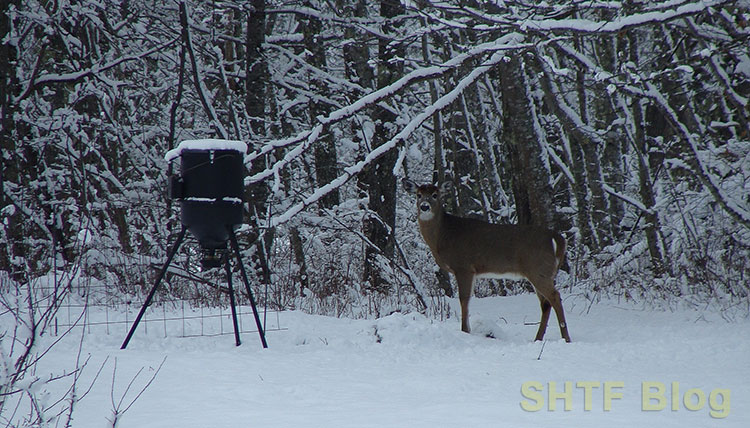
Long-term winter feeding isn’t necessarily a good thing. Concentrations of deer can spread diseases, attract predators, and create traffic hazards. Also, some feeds – like “deer corn” – are detrimental to the digestive systems of deer. That said, once deer season ends, all three of us fire up game feeders with oats and commercial deer pellets.
It’s a great way to conduct an informal post-season census – for a brief post-season period. Folks interested in seeing deer in their backyards could do worse than rake up a pile of acorns and/or apples. They may even show their appreciation by pruning your shrubs and fruit trees.
Closing Comments
We manage to refill our freezers annually, but it requires plenty of effort and the best ammo for deer. Both pre- and post-season scouting are part of the routine – with all intel and hunting calculated to minimize signs of human presence. Worth noting, deer can pattern hunters with uncanny effectiveness, meaning the continuous hunting of several “hot spots” will quickly educate deer. Better to diversify with the discipline to hunt only when conditions (like the wind) are ideal.
Lastly, the above deer pattens and diets will be more familiar to those residing in colder climes, perhaps like Michigan or Wisconsin. Alabama and Texas will no doubt differ in many respects, especially in regard to food preferences and the timing of the rut. Thus, for both deer and deer hunters, the same credo applies: adapt, overcome, and know proper deer shot placement.

